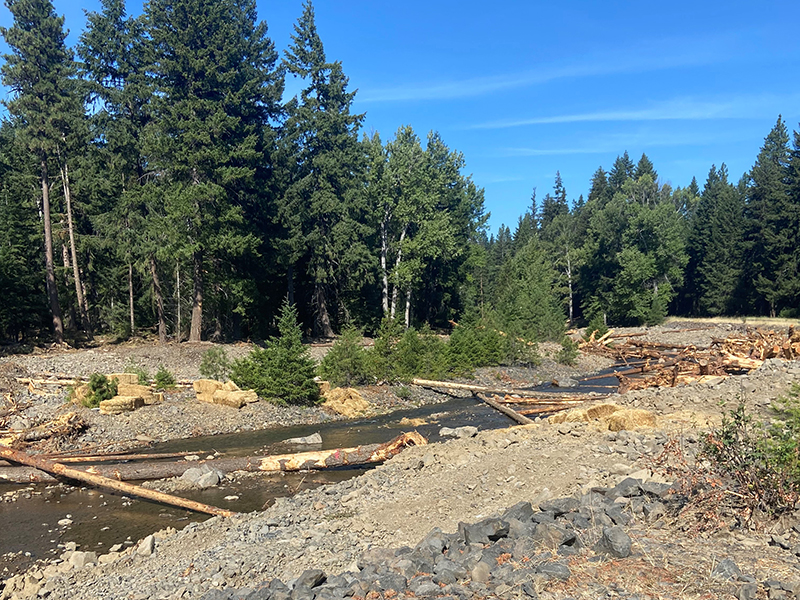
Sometimes the best of intentions don’t work out as hoped. More than 40 years ago, land managers built levees on the Little Naches River to protect Forest Service Road 1900 from flooding. They removed log jams and bulldozed the riverbed. The levees constricted the stream, keeping it from spreading out into its natural floodplain. This damaged habitat for many fish species, including endangered salmonids. The modifications also reduced fishing and wading opportunities in the most popular recreation area on the Naches Ranger District of the Okanogan-Wenatchee National Forest. That’s all changing, thanks in part to a 2020 Streamflow Restoration Grant from Ecology.
Collaboration: the big difference in Little Naches
Mid-Columbia Fisheries Enhancement Group worked with partners to put together a collaborative plan to reverse the damage and restore the habitat in a one-mile stretch of the river. The Little Naches Workgroup Aquatic Sub-Committee, staff from Yakama Nation Fisheries, the USDA Forest Service, Washington Department of Fish and Wildlife, NOAA Fisheries, U.S. Fish and Wildlife Service, Mid-Columbia Fisheries, and the Yakima Basin Fish and Wildlife Recovery Board met regularly with engineers from TetraTech, LLC to craft an effective restoration project.
In 2020, we awarded Mid-Columbia Fisheries a $1.175 million Streamflow Restoration grant. Additional funding from the Yakima Basin Integrated Plan and the Forest Service’s Central Washington Initiative allowed the project to take shape with a completion goal of Fall 2022. The project’s methods to hold water in the landscape and restore habitat include:
- Eliminate levees. The levees were ten feet high on the Kittitas County side and about five feet high on the Yakima County side. A small portion of one of the levees was left in place to limit flood risk to Forest Road 1900.
- Raise the sunken riverbed. All the rocks from the levees were returned to the streambed and raised the river’s bed by as much as four to five feet in some areas.
- Reconnect the floodplain. Eliminating the levees allows the river to slow down and return the stream to its natural floodplain. The water from the stream can spread out, limit erosion, and temporarily store excess water for drier times.
- Add wood to improve habitat and raise the streambed. The Forest Service donated nearly 600 full-grown trees with root wads. The beauty of this part of the project is that the wood was pulled from nearby tree thinning projects and didn’t need to be purchased and trucked in or flown in with helicopters, saving hundreds of thousands of dollars and decreasing the construction’s carbon footprint.
- Replant the riparian areas to increase floodplain roughness, shade, and future wood supply, reduce evaporation, keep the water cool, and habitat restoration for land-based forest creatures.
The first phase of the project was completed in September 2022. In Fall 2023, Mid-Columbia Fisheries will plant native trees to complete the project. The water table is now noticeably higher. There are areas of standing water and wet sand in the previously disconnected floodplain. Beaver have already moved in to start long-term site management. A bull trout was recently discovered, so there’s hope they’ll discover this new spawning habitat and return to this reach of the river in years to come.
“We are so grateful for the agencies, organizations, and individuals that work together for water, fish, and forest health in the Yakima Basin,” said Rebecca Wassell, Yakima Basin Program Director for Mid-Columbia Fisheries. “Collaboration is key to achieving meaningful habitat restoration — and it sure makes our projects for fun too.”
More grants to come
Our streamflow restoration competitive grants fund projects that improve rivers and streams in Washington. We support the work of state and local agencies, tribal governments, and non-profit organizations throughout the state. To learn more, visit our Streamflow Grant webpage.
Since 2019 we've awarded more than $40 million for 37 projects in watersheds throughout the state. We're planning to announce the next round of grant recipients early next month.



